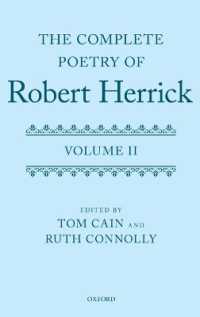- ホーム
- > 洋書
- > 英文書
- > History / World
Full Description
'Artistic Practices and Archaeological Research' aims to expand the field of archaeological research with an anthropological understanding of practices which include artistic methods. The project has come about through a collaborative venture between Dragos Gheorghiu (archaeologist and professional visual artist) and Theodor Barth (anthropologist). This anthology contains articles from professional archaeologists, artists and designers. The contributions cover a scale ranging from theoretical reflections on pre-existing archaeological finds/documentation, to reflective field-practices where acts of 'making' are used to interface with the site. These acts feature a manufacturing range from ceramics, painting, drawing, type-setting and augmented reality (AR). The scope of the anthology - as a book or edited whole - has accordingly been to determine a comparative approach resulting in an identifiable set of common concerns. Accordingly, the book proceeds from a comparative approach to research ontologies, extending the experimental ventures of the contributors, to the hatching of artistic propositions that demonstrably overlap with academic research traditions, of epistemic claims in the making. This comparative approach relies on the notion of transposition: that is an idea of the makeshift relocation of methodological issues - research ontologies at the brink of epistemic claims - and accumulates depth from one article to the next as the reader makes her way through the volume. However, instead of proposing a set method, the book offers a lighter touch in highlighting the role of operators between research and writing, rather entailing a duplication of practice, in moving from artistic ideas to epistemic claims. This, in the lingo of artistic research, is known as exposition. Emphasising the construct of the 'learning theatre' the volume provides a support structure for the contributions to book-project, in the tradition of viewing from natural history. The contributions are hands-on and concrete, while building an agenda for a broader contemporary archaeological discussion.
Contents
Contents; Introduction: Exposition and Transposition. Seeking an Ontologic Sensoriality in Contingencies - by Theodor Barth; Convergences: Archaeology and Art - by Giulio Calegari; Art as Entangled Material Practices. The Case of Late Iron Age Scandinavian Gold Foil Figures in the Making - by Ing-Marie Back Danielsson; The Mediality of Rock and Metal. Exploring Formal Analyses of Rock Art through Graffiti - by Fredrik Fahlander; The Diverse Sense of Frontality of Prehistoric Pottery: At the Time of Production, Deposition, and Publication/Exhibition - by Makoto Tomii; Art or Creativity? From Archaeological Photo-Ethnography to Art: Approaches to Two Contemporary Sites - by José Ant. Marmol Martinez; Heidegger at Work. An Archaeological Employment of a Theory of Truth in Art - by Ylva Sjostrand; Art and Thought - by Marcel Otte and Hans Lemmen; Experimenting the Art of Origins: Animating Images by Blowing Colours and Sounds - by Dragoş Gheorghiu; 'Who's Afraid of Virginia Woolf?' Art, Archaeology and Forensic Anthropology - by Theodor Barth and Ane Thon Knutsen; Epigraphy in the Landscape: Intersections with Contemporary Ink Painting and Land Art - by Lia Wei; Magnetic Boulders. Unfolding Stone with Gestures and Light - by Geir Harald Samuelsen; PORØS: A Model of Resistance as Material Communication - by Neil Forrest and Theodor Barth; Virtual Art in Teaching and Learning Archaeology: An Intermedia to Augment the Content of Virtual Spaces and the Quality of Immersion - by Dragos Gheorghiu and Livia Stefan







